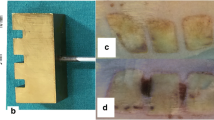Abstract
The purpose of medical treatment in the caustic esophageal burns (CEB) is to decrease inflammatory reaction and to prevent stricture formation. Resveratrol has anti-inflammatory and antifibrotic properties. The aim of this study is to investigate potential therapeutic effects of resveratrol in experimental CEB. We divided 42 male Wistar albino rats into five groups: a control group, caustic groups 4 and 28 (esophageal burns were created), and resveratrol groups 4 and 28 (esophageal burns were created and resveratrol was administered). We used 25% NaOH to form CEB following the method of Gehanno and Guedon as modified by Liu and Richardson. Animals were killed on the 4th and 28th days for biochemical and histopathological examinations. We found that the mean malondialdehyde and nitric oxide assays of the caustic groups were significantly higher than that of the resveratrol groups (P < 0.05). On the other hand, glutathione assay of the resveratrol groups was significantly higher than that of the caustic groups (P < 0.05). Histologically, edema, inflammation and necrosis were found to be significantly lower in the resveratrol 4 group compared with the caustic 4 group (P < 0.05). Submucosal and muscular collagen accumulation were found significantly lower in the resveratrol 28 group compared with the caustic 28 group (P < 0.05). We conclude that resveratrol decreased both the inflammatory reaction and the stricture formation in experimental CEB.




Similar content being viewed by others
References
Wasserman RL, Ginsburg CM (1985) Caustic substance injuries. J Pediatr 107:169–174
Karnak I, Tanyel FC, Buyukpamukcu N, Hicsonmez A (1999) Combined use of steroid, antibiotics and early bougienage against stricture formation following caustic esophageal burns. J Cardiovasc Surg (Torino) 40:307–310
Günel E, Çağlayan F, Çağlayan O, Canbilen A, Tosun M (2002) Effect of antioxidant therapy on collagen synthesis in corrosive esophageal burns. Pediatr Surg Int 18:24–27
Arbell D, Udassin R, Koplewitz BZ, Ohana M, Genina O, Pines M, Nagler A (2005) Prevention of esophageal strictures in a caustic burn model using halofuginone, an inhibitor of collagen type I synthesis. Laryngoscope 115:1632–1635
Temir ZG, Karkıner A, Karaca I, Ortaç R, Ozdamar A (2005) The effectiveness of sucralfate against stricture formation in experimental corrosive esophageal burns. Surg Today 35:617–622
Yeming W, Somme S, Chenren S, Huiming J, Ming Z, Liu DC (2002) Balloon catheter dilatation in children with congenital and acquired esophageal anomalies. J Pediatr Surg 37:398–402
Günel E, Çağlayan F, Çağlayan O, Akıllıoğlu I (1999) Reactive oxygen radical levels in caustic esophageal burns. J Pediatr Surg 34:405–407
Fremont L (2000) Biological effects of resveratrol. Life Sci 66:663–673
Johnson JL, Maddipati KR (1998) Paradoxal effects of resveratrol on the two prostaglandin H synthases. Prostaglandins 56:131–143
Jang M, Cai L, Udeani GO, Slowing KV, Thomas CF, Beecher CWW, Fong HHS, Farnsworth NR, Kinghorn AD, Mehta RG, Moon RC, Pezzuto JM (1997) Cancer chemopreventive activity of resveratrol, a natural product derived from grapes. Science 275:218–220
Olson ER, Naugle JE, Zhang X, Bomser JA, Meszaros JG (2005) Inhibition of cardiac fibroblast proliferation and myofibroblast differention by resveratrol. Am J Physiol Heart Circ Physiol 288:H1131–H1138
Moreno JJ (2000) Resveratrol modulates arachidonic acid release, prostaglandin synthesis, and 3T6 fibroblast growth. J Pharmacol Exp Ther 294:333–338
Chavez E, Reyes-Gordillo K, Segovia J, Shibayama M, Tsutsumi V, Vergara P, Moreno MG, Muriel P (2008) Resveratrol prevents fibrosis, NF- kappa B activation and TGF- beta increases induced by chronic CCI (4) treatment in rats. J Appl Toxicol 28:35–43
Gehanno G, Guedon C (1981) Inhibition of experimental esophageallye strictures by penicillamine. Arch Otolaryngol 107:145–147
Liu AJ, Richardson AM (1985) Effects of N-Acetylcysteine on experimentally induced esophageal lye injury. Ann Rhinol Laryngol 94:477–481
Mihara M, Uchiyama M (1978) Determination of malonaldehyde precursor in tissues by thiobarbituric acid test. Anal Biochem 86:271–278
Fontecave M, Lepoivre M, Elleingand E, Gerez C, Guittet O (1998) Resveratrol, a remarkable inhibitor of ribonucleotide reductase. FEBS Lett 421:277–279
Wennmalm A, Benthin G, Peterson AS (1992) Dependence of the metabolism of nitric oxide (NO) in healthy human whole blood on the oxygenation of its red cell hemoglobin. Br J Pharmacol 106:507–518
Cortas NK, Wakid NW (1990) Determination of inorganic nitrate in serum and urine by a kinetic cadmium-reduction method. Clin Chem 36:1440–1443
Millar AJW, Cywes S (1998) Caustic strictures of the esophagus. In: O’Neill JA, Rowe MI, Grosfeld JL (eds) Pediatric surgery. Mosby Year Book Inc, St Louis, pp 970
Van der Vliet A, Bast A (1992). Role of reactive oxygen species in intestinal diseases. Free Radic Biol Med 12:499–513
Villa P, Soccani A, Sico A, Ghezzi P (2002) Glutathione protects mice from lethal sepsis by limiting inflammation and potentiating host defence. JID 185:1115–1120
Bekyarova G, Yankova T (1998) Alpha-Tocopherol and reduced glutathione deficiency and decreased deformability of erythrocytes after thermal skin injury. Acta Physiol Pharmacol Bulg 23:55–59
Sekhar KR, Spitz DR, Haris S, Nguyen TT, Meredith MJ, Holt JT, Gius D, Marnett LJ, Summer ML, Freeman ML, Guis D (2002) Redox-sensitive interaction between KIAA0132 and Nrf2 mediates indomethacin-induced expression og gamma-glutamylcysteine synthetase. Free Radic Biol Med 32:650–662
Kim SM, Byun JS, Jung YD, Kang IC, Choi SY, Lee KY (1998) The effects of oxygen radicals on the activity of nitric oxide synthase and guanylate cyclase. Exp Mol Med 30:221–226
Leiro J, Alvarez E, Garcia D, Orallo F (2002) Resveratrol modulates rat macrophage functions. Int Immunopharmacol 2:767–774
Draper HH, Hadley M (1990) Malondialdehyde determination as index of lipid peroxidation. Methods Enzymol 186:421–431
Godichaud S, Krisa S, Couronne B, Dubuisson L, Merillon JM, Desmouliere A, Rosenbaum J (2000) Deactivation of cultured human liver myofibroblasts by trans-resveratrol, a grapevine-derived polyphenol. Hepatology 31:922–931
Acknowledgment
We thank Fisun Hamaratoglu (MDACC, Houston, TX, USA) for critical reading of the manuscript.
Author information
Authors and Affiliations
Corresponding author
Rights and permissions
About this article
Cite this article
Uguralp, S., Irsi, C., Aksoy, T. et al. Resveratrol attenuates inflammation and stricture formation in experimental caustic esophageal burns. Pediatr Surg Int 24, 425–430 (2008). https://doi.org/10.1007/s00383-008-2116-x
Accepted:
Published:
Issue Date:
DOI: https://doi.org/10.1007/s00383-008-2116-x




